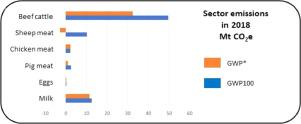Livestock Science ( IF 1.8 ) Pub Date : 2021-02-22 , DOI: 10.1016/j.livsci.2021.104459 Bradley Ridoutt

|
The livestock industries are responsible for a variety of greenhouse gas (GHG) emissions that vary in atmospheric lifetime and radiative efficiency. Assessing the overall contribution to climate change and the priority of different mitigation actions is not straightforward. Commonly applied climate metrics, such as GWP100, obscure the different timeframes over which climate impacts occur and may not provide suitable information for every decision-making context. The GWP* climate metric has been developed to describe the future warming associated with a change in rate of emission of a short-lived climate forcer, like methane, compared to a pulse emission of CO2, a long-lived climate forcer. This metric can be used to guide climate action aligned with temperature-based climate stabilization goals, as expressed in the Paris Agreement. In this study, GHG emissions were assessed for Australian livestock industries – beef cattle, sheep meat, chicken meat, pig meat, eggs and milk – using both GWP100 and GWP* metrics using data primarily sourced from the Australian Greenhouse Emissions Information System spanning 1990 to 2018. Over this period, all industries increased their production. For livestock industries having substantial methane emissions, important differences were observed between results obtained using the two metrics. In the case of sheep meat production, the industry was assessed as emitting 10.3 Mt CO2e in 2018 using the GWP100 metric. However, using the GWP* metric the GHG emissions footprint was equivalent to 2.85 Mt CO2 removal. The design of the GWP* climate metric makes it particularly suited to the management of emissions in line with climate stabilization goals and there is a need to assess the continuing relevance of GHG mitigation strategies developed using the GWP100 climate metric. Strategies to achieve reductions in methane emissions at the expense of increasing CO2 and N2O emissions are concerning. Assessed using the GWP100 climate metric, these strategies may appear to be making progress in combating climate change. However, they may be achieving a short-term climate benefit while making climate stabilization more difficult.
中文翻译:

简短交流:使用全球升温潜能值*气候指标评估的澳大利亚畜牧生产对气候的影响
畜牧业负责各种温室气体(GHG)排放,这些排放在大气寿命和辐射效率方面有所不同。评估对气候变化的总体贡献以及采取不同缓解措施的优先次序并非易事。通用的气候指标(例如GWP100)掩盖了气候影响发生的不同时间范围,并且可能无法为每个决策环境提供合适的信息。已开发了GWP *气候指标,以描述与CO 2脉冲排放相比,短期气候压力如甲烷的排放速率变化带来的未来变暖。,长期的气候压力。正如《巴黎协定》所表达的那样,该指标可用于指导符合基于温度的气候稳定目标的气候行动。在这项研究中,使用GWP100和GWP *指标,同时使用主要来自澳大利亚温室气体排放信息系统的数据(从1990年到2006年2018年。在此期间,所有行业都增加了产量。对于甲烷排放量较大的畜牧业,使用这两个指标获得的结果之间存在重要差异。就绵羊肉生产而言,该行业被评估为排放了10.3 Mt CO 2在2018年使用GWP100指标。但是,使用GWP *度量标准,GHG排放足迹相当于去除2.85 Mt CO 2。GWP *气候指标的设计使其特别适合根据气候稳定目标进行的排放管理,并且有必要评估使用GWP100气候指标制定的温室气体减排战略的持续相关性。涉及以减少CO 2和N 2 O排放为代价的减少甲烷排放的策略。通过使用GWP100气候指标进行评估,这些策略在应对气候变化方面似乎正在取得进展。但是,他们可能会在短期内获得气候收益,同时使气候稳定更加困难。


























 京公网安备 11010802027423号
京公网安备 11010802027423号